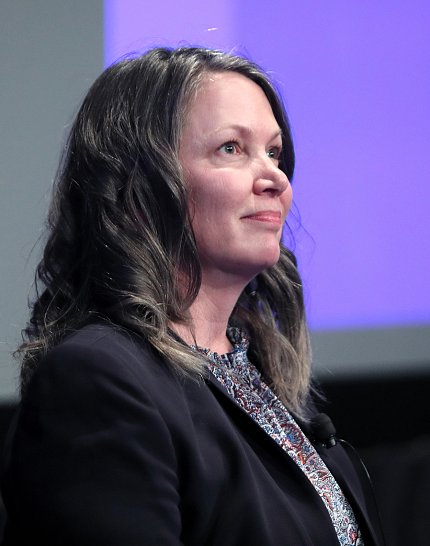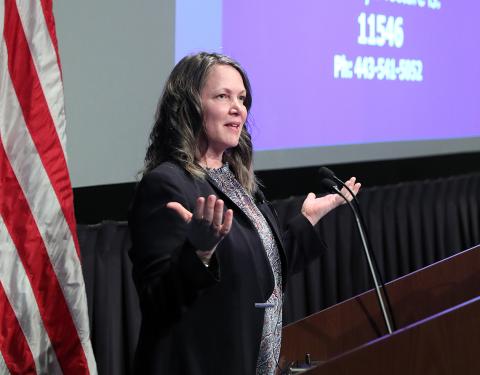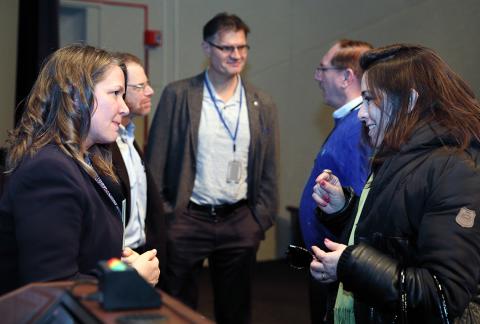Symptom Management
Armstrong Surveys Rare Cancer Patients

Photo: Chia-Chi Charlie Chang
Getting diagnosed with cancer is a frightening, uncertain experience. Already anxious about their prognosis, patients also must brace themselves for intensive and sometimes lengthy treatment and the potential for serious side effects from therapy and symptoms of the disease. For cancer patients, the overall care they receive is crucial.
“Sometimes it’s the journey that tells you more about that experience with cancer than the actual diagnosis does,” said Dr. Terri Armstrong, senior investigator in NCI’s Neuro-Oncology Branch (NOB), at the Center for Cancer Research Grand Rounds held recently in Lipsett Amphitheater.
Armstrong’s research focuses on predicting and managing symptoms better, an interest she developed early in her career while observing patients experience significant symptoms from the cancer itself, compounded by those associated with treatment such as nausea, vomiting, diarrhea and fevers.
“Every day, I saw the impact of both the disease and the treatment on the patients we were caring for,” said Armstrong. Some of those patients were close relatives.
While Armstrong was in college, her mother was diagnosed with cancer. Soon after, her grandmother, great-grandmother and two maternal aunts were in the same fix.
“I lost some of the most important women in my life during that time and that truly influenced my perspective,” Armstrong said.
Over the years, she has learned the importance of letting patients define their own reality and what life quality means to them. Doctors should weigh in, she said, but ultimately the patients’ wishes and goals should guide treatment.
Armstrong primarily works with people who have central nervous system (CNS) tumors. This type of cancer is rare, about 2 percent of all cancers, but most of these patients have a poor prognosis.
Some 700,000 Americans are currently living with a primary CNS tumor. From the time of diagnosis, the majority are unable to work and, during the course of the illness, half of them have as many as 10 current symptoms at any one time; 40 percent report at least 3 ongoing symptoms they described as moderate to severe in intensity. One large patient sample showed that CNS tumor patients have stress, fatigue and sleep disturbances at the same level as patients having other high-risk cancers.
“The symptom burden has an impact on functional status, disease progression and survival,” said Armstrong.
There is increasing recognition in those providing care and in the drug approval process that understanding how a treatment affects how a patient feels or functions is an important consideration when evaluating its effect.

Photo: Chia-Chi Charlie Chang
Quality of life is also important, but some patients had reported their quality of life as being very good, despite their serious symptoms. Armstrong said she then realized that many factors, beyond biological ones, influence a patient’s quality of life, including family support, social interactions, financial situation and emotional well-being. This led to her focus on symptoms, which may be a closer surrogate of the impact of the disease and treatment.
To gauge symptoms and their effect on daily life, she developed a short, simple questionnaire that, along with neuropsychological testing, has been adopted by many brain tumor clinical trials.
In a phase 2 clinical study, the drugs lapatinib and temozolomide (TMZ) were given to highly symptomatic patients with recurrent ependymoma tumors. Most patients on this treatment had stable disease on imaging, while their weakness, pain and numbness significantly lessened. Armstrong said the trial showed the prospects of controlling tumor growth while ameliorating patients’ symptoms.
To reach even more patients with rare CNS tumors, Armstrong and her colleagues started a web-based study to reach patients where they live and not be dependent on them being seen in a specific hospital. Armstrong led the ependymoma outcomes project for the CERN (Collaborative Ependymoma Research Network) Foundation to help share information and improve care among rare tumor populations. This work also included collecting clinically annotated tumor samples to learn more about the predictors of survival and outcome in patients with ependymoma.
The investigators published one of the largest studies exploring survival outcomes, important preliminary work that, along with seminal work by other researchers, has led to the identification of subtypes of ependymoma.
Armstrong is now partnering with other researchers, including Drs. Michael Scheurer and Cari Kitihara, collecting germline DNA and environmental exposure history to explore why people develop this rare cancer.

Photo: Chia-Chi Charlie Chang
Meanwhile, Armstrong leads NOB’s natural history study, enrolling all CNS tumor patients undergoing longitudinal follow-up at NIH. In just over a year, the program has enrolled at least 340 patients and will continue gathering clinical outcomes, molecular tumor analyses and other relevant data.
Armstrong also aims to better predict symptom risk. Current symptom management, she said, involves reducing doses or stopping treatment, or providing prophylaxis to all patients receiving treatment or waiting for symptoms to occur and trying to mitigate them.
“What if instead we can understand who is at predisposed risk of developing the toxicity and target that or not expose patients at undue risk to that agent?” Armstrong asked. “Or, if we understand the biological process, then we target that process, and perhaps we can keep the symptom or toxicity from occurring altogether.”
The most common therapies for primary brain tumors are radiation and TMZ chemotherapy. A significant symptom with TMZ is myelosuppression, which dampens the immune system. One study found women at heightened risk for toxicity with TMZ.
In a second study, 80 percent of patients reported fatigue and hypersomnia during cranial radiation therapy. The team found two genes associated with inflammation and the circadian clock—BMAL and PER2—that may be inducing fatigue in brain tumor patients, said Armstrong.
Studying the biological basis of symptoms will allow doctors to change approaches to prevent symptoms in at-risk patients and increase therapies in those not at risk.
It’s also important to remember, said Armstrong, to remain optimistic, because there are novel treatments and patients who beat the odds. One such patient, after learning he had 6 months to live, enrolled in a clinical trial and is alive and well more than 20 years later.
“Statistics are just statistics and they mean almost nothing for our individual patients,” said Armstrong. “They provide a framework, but none of us know what the future will be.”
